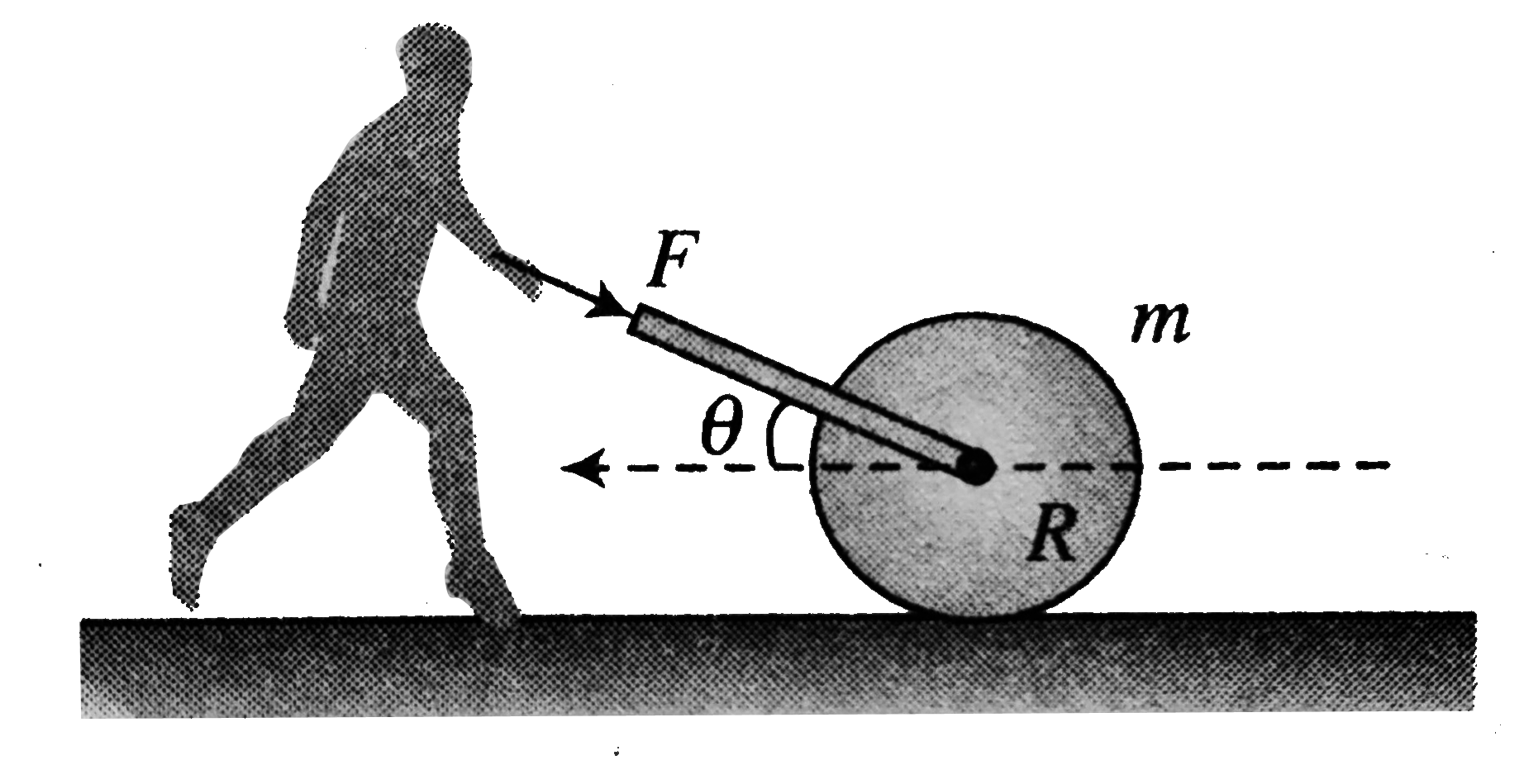A gardener presses the grasscutter with a force F at an angle θ. Assume the motion of grasscutter as pure rolling. Find the:

Acceleration of CM of the roller (disc). Assume that the mass of the disc is m and neglect the mass of the connecting rod.
2Fcosθ3m
Fsinθ3m
2Fsinθ3m
Fcosθ3m
The correct Answer is:A
Fcosθ−f=ma …………i
fR=12mR2α⇒fR=12mR2aR
⇒f=ma2………ii
From i and ii

f=Fcosθ3
Now a=2fm=2Fcosθ3m
f≤f1⇒Fcosθ3≤μN
⇒Foscosθ3≤μ(mg+Fsinθ)⇒F≤3μmgcosθ−3μsinθ
Topper's Solved these Questions
- RIGID BODY DYNAMICS 2BOOK - CENGAGE PHYSICSCHAPTER - RIGID BODY DYNAMICS 2EXERCISE - Integer
7 Videos
- RIGID BODY DYNAMICS 2BOOK - CENGAGE PHYSICSCHAPTER - RIGID BODY DYNAMICS 2EXERCISE - Fill In The Blanks
7 Videos
- RIGID BODY DYNAMICS 2BOOK - CENGAGE PHYSICSCHAPTER - RIGID BODY DYNAMICS 2EXERCISE - Multiple Correct
26 Videos
- RIGID BODY DYNAMICS 1BOOK - CENGAGE PHYSICSCHAPTER - RIGID BODY DYNAMICS 1EXERCISE - Integer
11 Videos
- SOUND WAVES AND DOPPLER EFFECTBOOK - CENGAGE PHYSICSCHAPTER - SOUND WAVES AND DOPPLER EFFECTEXERCISE - Integer
16 Videos
Similar Questions
Neglecting friction and the mass of the pulleys, find the acceleration of the mass Q assuming that P=Q (Figure 5.20).
View SolutionA force F is applied on a spool (mass m and radius R) in vertical direction as shown in case I and case II. The radius of gyration k of spool is R/(√2). Assuming pure rolling, find the acceleration of the CM of the body, assuming it as a uniform cylinder of mass m.

View Solution
Knowledge Check
A gardener presses the grasscutter with a force F at an angle θ. Assume the motion of grasscutter as pure rolling. Find the:

friction between the grasscutter (assumed as a disc) and ground.AFsinθ3BFcosθ3C2F3D2Fcosθ3A gardener presses the grasscutter with a force F at an angle θ. Assume the motion of grasscutter as pure rolling. Find the:

Maximum force F for no relative slidng if th coeficient of friction between the roller and ground is μAμmgcosθcosθ+3μsinθBμmgsinθcosθ+3μsinθC3μmgcosθ−3μsinθD3μmgcosθ+3μsinθFind the acceleration of the block of mass m. Assume pulleys are massless and frictionless.
 Ag/3B2g3Cg2DNone
Ag/3B2g3Cg2DNone
A truck of mass M has 4 wheels. The surface area of the metal disc in each wheel is A. When brakes are applied the brake shoe in each wheel rubs against the metal disc. This produces heat. We will assume that this heat is used to heat the disc in the wheel only. Each disc has mass m and is made of material of specific heat capacity s. One day the truck was going downhill on a road inclined at angle θ to the horizontal. To maintain a constant speed v the driver had to apply brakes. The only other dissipative force, apart from the brake force, on the truck is the air resistance force that is equal to F. Assume no heating of discs due to air friction.
(a) Find the initial rate of rise of temperature of each metal disc after the brakes are applied.
(b) Find the final temperature (T) of the disc assuming that it is a black body and it loses heat only through radia- tion. Take the atmospheric temperature to be T0
View SolutionAssuming all the surfaces to be smooth, find the acceleration of the triangular block of mass M when the block of mass m slides on it.

View SolutionFind moment of inertia of a sector cut from a disc of mass M, radius R and central angle θ
View SolutionThe acceleration of the centre of mass of a uniform solid disc rolling down an inclined plane of angle θ is
View SolutionA force F acts tangentially at the highest point of a disc of mass m kept on a rough horizontal plane. If the disc rolls without slipping, the acceleration of centre of the disc is:

View Solution
